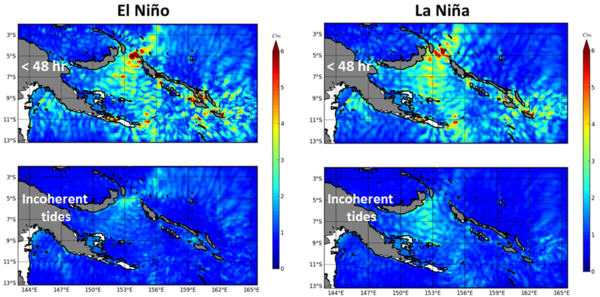Internal tides in the Solomon Sea change with ENSO phases
Image of the Month - September 2019

The Solomon Sea in the South-west Pacific is a semi-enclosed sea, bordered by the island of New Guinea to the West, the islands of New Britain and New Ireland to the North, and the Solomon Islands to the East. The circulation in this basin is highly constrained by those islands and the bathymetric features surrounding them. Moreover, the Solomon Sea is highly sensitive to the ENSO phases, which modulate mesoscale activity and stratification. The principal lunar semidiurnal constituent (M2) generates there energetic internal tides at three principal sites where strong tidal currents encounter sharp topography in the stratified ocean. Thus this Sea enables to study the diversity of internal tide signature with differences depending on the ENSO phases, in particular if looking at 1997-1998 (strong El Niño) vs 1999 (strong La Niña).
A study shows that La Niña, with a high level of mesoscale activity, favors the appearance of incoherent internal tides while El Niño, with a stratification close to the surface, is more characterized by small scale coherent tide-induced sea surface heights.
A global view of internal tide generation, propagation, and dissipation has emerged in recent years, mainly from satellite altimetry observations and global high-resolution numerical models. However, a better knowledge of internal tides, both coherent and incoherent, is primordial for Swot altimetry mission. This study in the Solomon Sea shows the complexity in predicting internal tides. This knowledge will be mandatory to access meso and submesoscale signatures from the future Swot mission.
See also:
- Applications/ocean: Internal tides
- Image of the Month, November 2007: The ocean is going up and down around the Solomon Islands
- Missions: Swot
References:
- Tchilibou, M., Gourdeau, L., Lyard, F., Morrow, R., Koch Larrouy, A., Allain, D., and Djath, B., 2020: Internal tides in the Solomon Sea in contrasted ENSO conditions, Ocean Science, 16, 615–635, https://doi.org/10.5194/os-16-615-2020.




